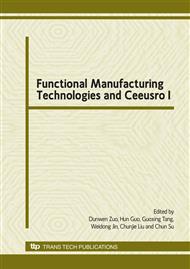p.391
p.395
p.399
p.403
p.409
p.413
p.417
p.422
p.427
A Simultaneous Smooth Processes Using Burnishing and Elecrofinishing on the Plane Surface
Abstract:
For the purpose of elevating the efficiency of the finish effect to reach the fast improvement of the surface roughness of the plane surface, so as to reduce the residual stress on the surface efficiently. This study discusses the plane surface after traditional grinding machining, of which the plane surface used a new design of finish-tool includes a nonconductive burnishing-tool and a negative electrode to execute the simultaneous processes of burnishing and electrofinishing. In the experiment, the use of the small thickness of the negative electrode is advantageous to the finish effect. High rotational speed of the finish-tool produces better polishing. Higher current rating with quicker workpiece feed rate effectively reaches the fast improvement of the surface roughness of the workpiece. The finishing effect is better with longer off-time because discharge of the electrofinishing dregs becomes easier. The experimental results show that the supply of current rating is near concern with the position of the negative electrode and the burnishing-tool.
Info:
Periodical:
Pages:
409-412
Citation:
Online since:
January 2010
Authors:
Price:
Сopyright:
© 2010 Trans Tech Publications Ltd. All Rights Reserved
Share:
Citation:


